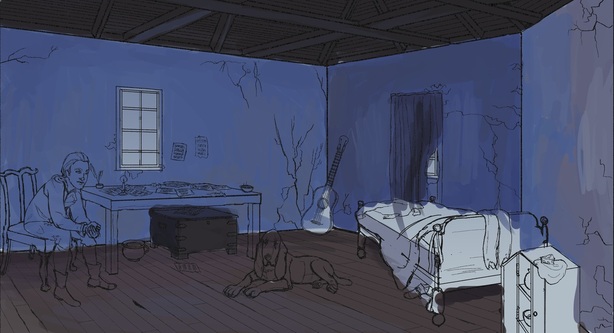After I finish the line drawing (expect a future blog post discussing my process for draftsmanship), I fill the canvas with a gradient with the basic colors that I want for the scene. In this case, I knew outside was going to be dusk, so I made the gradient closer to the correct color for outside. The gradient helps me to see past the blank canvas and to better realize the color palette.
Then I paint the sources of light, and the highlights that go with that. For this, I knew there would be a single candle lit on the table, a fire lit out of frame on the bottom right, and some light filtering in from the window. Lastly, I paint in the shadows. And that's it! I try to work in a bigger canvas than the picture frame, so that the painting stays loose and natural. It's easier to draw through and paint through this way. I usually only crop it for the final image (although I cropped the other versions for this post). My color studies are usually fairly complete. Final color adjustments come at the end, but figuring out all the color and light play helps the final painting to go a lot faster and smoother.
0 Comments
I even went so far as to make formal model sheets and prop sheets to show their different outfits and shoes, and the menu of The Cheesy Burger, the local joint that the Gals frequent. Maybe I did too many sketches, but I think it really helped my final pieces go much more smoothly, so I have no regrets. I work predominantly in natural light, so it was very refreshing and exciting to delve into artificial. One thing that is always important, but especially in paintings like these, is to consider where your light is coming from, and where it bounces. Since the sources of man-made lighting are usually much closer to the subject, the bounce factor is greater. Pay attention to parallel and perpendicular surfaces, they reflect the same light differently. It helps to do studies from life. If you don't have a model on hand, grab a mirror and a light, and get to work on self portrait studies. That's what I did! For my club scene, I knew shadows would be an important element, so I made sure to sketch out the forms they came from in order to accurately depict them. Even if you stray from your sketch, at least the foundation makes sense. You can only go up from there. After doing finalized line work, I did a fairly final color study, figuring out the local colors, shadows and bounce light. For me, it is very easy to muddy local color (the natural color of a thing as perceived in daylight i.e. red apple) by painting opaque highlights and shadows on top; it is very important to consciously select the local color and think through what is affecting it before settling. After finalizing all the painted elements, I added a layer of blurred glows, an opaque layer of additional shadow set to "Multiply" and a gradient overlay going from orange to indigo set to "Vivid Light" and brought down to about 20% opacity. I find these really help to unify the image into a completed piece. The process for my diner painting was very similar, although I hid a few photo textures in this one. Overall, I think I succeeded in my studies of neon lights, and more to my surprise, I bettered my local color, a demon I have battled for a long time.
|
Meghan Boehman Art
Art tips I learn and helpful resources that I find. Archives
April 2016
|

















 RSS Feed
RSS Feed
